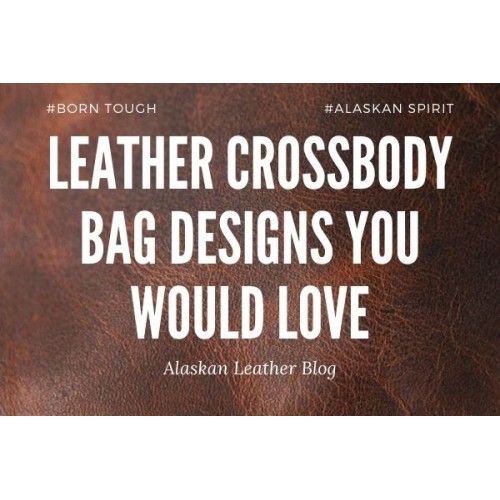Leather goods have been in use for many thousands of years. In the ancient times our ancestors used to hunt in the Stone Age for food and later would use the leather hide obtained from those wild animals for clothing etc. Since then the trend of using material made out of leather has carried on.
Discoveries from the ancient Egyptian island of Elephantine dated well after the 4th century depicted the use of leather in footwear. Certain paintings and art object clearly show that leather was often used in clothing, footwear & also some military gear. The Egyptians developed the process of vegetable tanning around 400 BC. Some researchers believe that the Greeks had developed the process of vegetable tanning by leaving the hide in water that contains tree bark and leaves. Archaeologists researching the Greek ruins found out that leather shoes were worn by wealthy and influential people. It was later recognized that bark of trees that contained “tannin” was ideal for transformation of raw animal hide to leather. This led to the discovery of tannic acid, which is used in leather tanning these days.
A Timeline Of Leather History
Stone Age
Archaeologists discovered that the Stone Age people used sharpened bones of animals to extract animal hides. It was common in the stone age to make use of tools made out of stones and bones and clothing was one of the common usage of leather. The most common method of leather treatment in this age involved stretching the leather hide after tying its end to a wooden frame so that it can dry and stretch thus making it useable to some extent. However the quality of the hide was still not that good.
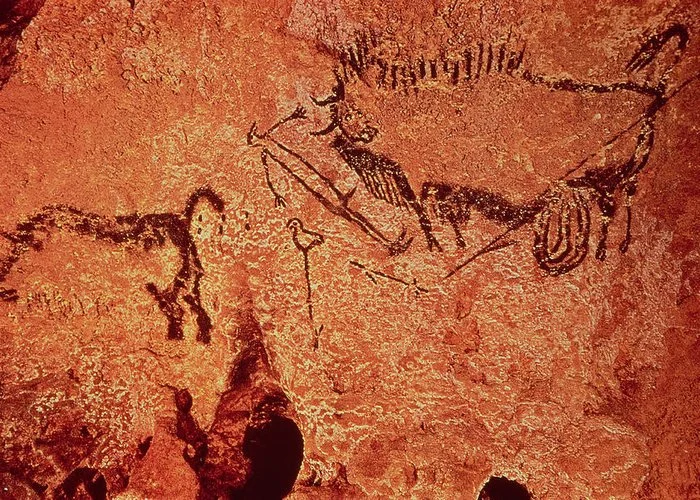
Stone marking from the stone age
Bronze Age
It was in the Bronze age that humans eventually came to grips with methods that enabled them to produce leather that could be used for longer stretch of time. This age gave rise to the leather tanning process which resulted in improved leather quality and thus leather craft started to evolve more rapidly. Leather was incorporated into more items like shoes, decoration items and jewelry.

Bronze age leather process
Leather treatment using acorns was normal in this age, and people used to treat the hide using boiled water containing acorns. The presence of oak in water points out to the fact that Tannin acid was used for treatment of hide.
Iron Age
Leather crafting techniques evolved quite well and were widespread throughout the different regions of the world in Iron age. The quality of leather artefacts found from this age points to the fact that leather crafting had become a profession with some objects clearly designed by expert crafters. The use of raw leather along with several other items such as adhesives, wood and metal ultimately meant people used to learn leather crafting as a profession.
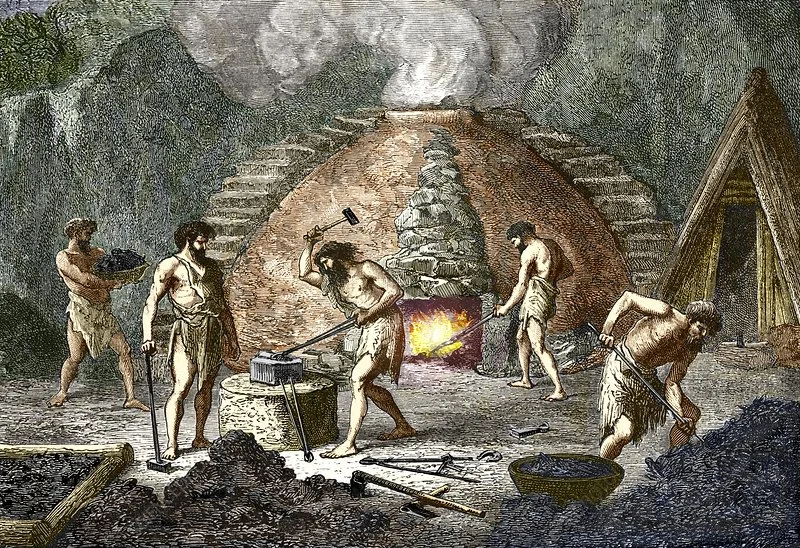
Iron age leather craftmanship
Ancient Egypt (3000 BC – 332 BC)
Findings from the ancient dynasty of Egyptian rulers such as Zanakht, Huni & later show the usage of leather in many aspects of their lives. One of the famous finding consists of a leather casing over a wooden chariot.
Studies suggest that during the Pharonic Era wearing leather shoes was a symbol of high status in the society. The Egyptians mastered the art of creating leather from hides of sheep, goat and cow. Leather became more commonly used for different utility purposes for example joining the furniture parts, soles of footwear, cases for certain sharp objects etc. For decorative purposes leather was also dyed using mineral dyes. Dyes obtained from fruits and leaves was also used, one e.g of such fruit is pomegranate that was used to obtain red color. Certain tools made out of bones and copper metal were invented for leather stitching.
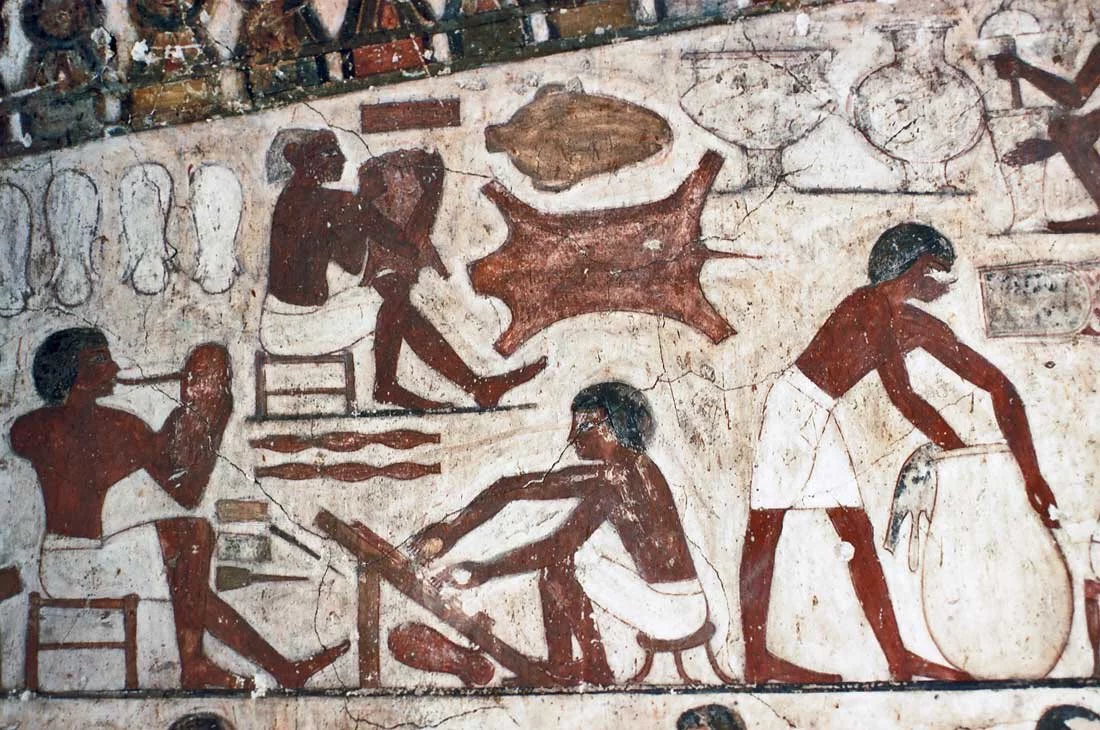
Leather work in ancient egypt
After the New Kingdom dynasty came into power leather craftsmanship became more popular and it was incorporated in the making of several decorative items.
Ancient Asia
Leather like other regions was an important part of ancient India. Several religious scriptures reference “Mashaks”, which is a sack used to carry water. The Rgveda refers to tanning as “Carmamna” which shows that leather was treated before consumption. Certain professions were considered to be dignified professions and Tanning was one of them. Dear skin was considered very valuable and was often worn by pious people of the society such as saints.

Ruins from an old temple in India indicating leather crafters
Leather also played a major role in trade in ancient India, as items made out of leather were traded across the silk route. The most common items included sacks (Mashaks as referred in the Hindu holy scriptures of the Vedas), straps, embroidered leather sheets etc.
In ancient China, leather was a common feature in warfare. Warriors used to protect themselves with armor that was often sewed onto leather. Shang dynasty (1600-1046 BC) first introduced the concept of tailored armor as leather provided a stable and durable base for the heavy metal pieces. For this purpose hide obtained from buffalos and rhinos was commonly used as it was tough and did not needed a lot of processing.
The Mongolian empire also followed a similar pattern like ancient China and made use of leather for combat related aspects of their lives. Their soldiers used to wear a mix of heavy armor that was padded using leather. Leather belts were given as gifts to neighboring rulers with whom diplomatic relations played a key role. The famous Mongol Warrior helmet, had leather covering hanging from its side for protection of ears from cold and freezing breeze. Since the Mongol warriors had to bear extreme cold temperatures they invented boots out of animal hide that would go until knee height. Sometimes they would tie up the long sleeve of boots with leather laces to protect feet from the cold weather.
History of Leather in Europe
In ancient Greece, the use of sandals was very common among people. In fact the word sandals originates from Greek word of “sandalon”. The Greek sandals were easily distinguished by their long straps that could be tied around the feet. The reference of such sandals can even be found in the Greek mythology with Hermes (God`s messenger) wearing them. The Greek sandals were made of colored leather and the sole was divided into many layers of livestock hide.
The Romans used to adopt a method called “Tawing” for leather processing. Tawing involves creating a solution out of flour or any binder together with aluminium salts and then soaking the animal hide in that solution. Upon drying the softness, and stretching ability of leather improves. Roman military was one of the biggest consumer of leather mostly using it for tent covers, boots and belts. The Romans were known to make quality footwear using leather.
Before Roman Empire, the Etruscans brought the idea of sandals from Greece. They used to wear leather boots curled upwards from toes and tied with leather straps. The outdoor shoe worn by the Romans was called “Calceus”. Besides this several other forms of shoes were invented by the Romans in which leather was always the common feature.

Viking & Romans warrior dresses made out of leather
Scandinavian Vikings in the early ages heavily used leather for a variety of purposes. Shoes, belts, bottle covers were made of leather after tanning the hide. The Vikings were skilled leather crafters and archaeologists have found several leather goods made that were made by professional leather crafters.
The Industrial Revolution and Changes In Leather Processing
The industrial revolution brought a manifold shift into manufacturing and consumption patterns across different sectors and the leather industry was no different. Manufacturers came up with smarter ways to produce greater quantities in order to meet the ever increasing demand. One great innovation to the tanning process has been Chromium Tanning which greatly reduced manufacturing time of finished leather hide providing greater quantities for end product tailoring.

Leather cutting process
The modern day tanning is a lengthy process that consists of several sub steps such as:
Soaking:
Hide is soaked in water to remove the salt applied in the initial stage.
Liming
In order to completely remove animal hairs out of the hide it is soaked in solution made out of sulphur.
Fleshing
During Fleshing any additional or excess debris is removed over the hide.
Splitting
As the name suggests, the leather sheets are cut into horizontal even surfaces. The bottom layer can be used for padding and other uses where as the front layer can be used for apparel, footwear, bags etc
Pickling
Pickling is used to increase the acidity of raw hide. This helps to prepare hide for chromium tanning. This helps to preserve the leather for longer periods of time.
Tanning
This is one of the most important steps where animal hide or skin is dipped in solution containing tannic acid. This solution eventually converts the hide to leather.
Equalizing
Equalizing is often referred to as leather shaving. It involves removal of any leftover fiber at the backside of leather in order to produce a homogenous thickness.
Dyeing or Coloring
Leather dyeing could be performed either with hand or using a machine (Aniline dyeing). Hand based dyeing generally is a multi-step process which increases the value of leather further.
Drying
After dyeing, the leather is left hanging for drying so that it can absorb the color homogenously across its grain.
After Drying the finished leather sheet ready to be consumed for production is ready.
Leather Quality and Characteristics
A lot of people might think why leather should be used as a material?
The secret of leathers success lies inside its placement of complex natural fibres that ultimately guide the different variations in its characteristics. On top of that the treatment of leather further enables different qualities to be further refined such as color, thickness, strength, pattern, hardness, water absorption etc.

Each leather type has a difference in its characteristics
Hardness
The hardness of leather is directly proportional to the fiber connections inside it. The tighter they are the harder the leather would be. The tanning process can further affect the softness of the material.
Strength
Leather strength plays an important factor in its wear and tear. Whether leather should be hard depends on the purpose it is used for. For e.g. the sole of leather is supposed to be hard. In order to increase the strength of leather it is pressed while it is wet which helps to strengthen the fiber structure. Just like hardness, tanning effects the strength of leather as well.
Surface
The perceived quality of leather surface is an outcome of a number of factors. There are hundreds of different types of leather surfaces that are used for a number of different purposes based on their surface texture. Following are some different types of leather commonly in used these days
1: Aniline & Semi Aniline Leather
Aniline Leather are dyed with soluble dyes which makes the color penetrate to its second or internal layer as well. The natural strains and markings on the leather remain intact because the exterior surface is not coated with any other material or chemical.
Semi aniline leather on the other hand also includes a slight pigmented coating on its exterior surface.
2: Vintage and Antique Leather
Vintage leather is basically top quality full grain leather that has been secured for a very long period of time. Vintage leather has wrinkles and imperfections and distinct worn out features.
3: Pigmented Leather
Pigmented leather has a thick coating of color pigment on its top surface. Prior to pigmentation the surface is buffed to remove any natural scars and marks on the skin.
4: Smooth Leather
The grain surface of leather is dyed in such a way that it gives a smooth and homogeneous texture. Generally smooth leather is water resistant.
5: Double Leather
When leather can be used from both of its side it is referred to as double leather. An e.g is the sheep skin generally being sold for decorative purposes. The front side consists of wool which can be used for decorative purposes while its back side consists of finished leather.
6: Embossed Leather
Leather can sometimes processed to have embossed beautiful patterns using thermal machines that presses the pattern on the leather sheet. The end result consists of embossed patterns on the leather.
7: Vegan & PU Leather
PU leather is an alternative form of original leather. PU refers to polyurethane leather which is artificially created using leather fibers of cowhide, combining them and applying a thick layer of polyurethane on top of it. PU leather is known by several different names such as:
Bonded Leather, Split Leather, Bicast Leather, Faux Leather, Vinyl Leather, Vegan Leather
8: Nubuck Leather
The Nubuck Leather is obtained by buffing and sanding the grainy surface of leather. The surface of Nubuck leather feels like velvet and gives a smooth feeling. These days nubuck leather is widely used for jackets, handbags, furniture and shoes.
9: Nappa Leather
Nappa leather gives an extra soft feeling to leather and is mostly used in luxury items such as car seats of expensive cars. Sometimes faux leather is also referred to as nappa leather as it also has a very soft surface (although its artificial). Nappa leather is produced from skin of calves, small goats and lambs.
10: Suede Leather
Suede leather consists of the inner surface which gives a more soft and luxurious feeling. The thicker suede hide is considered durable but it can also get very expensive.
There are still some other forms of leather such as:
Waxed leather, printed and pigmented leather, stretch leather, Woven leather etc.
Leather Goods
The leather industry has evolved ten folds in the modern century. From apparel to holders, furniture to office items and automotive you will see leather being consumed in one way or the other. Below is a list of different leather goods in common use these days.
Leather Apparel
1: Leather Footwear
Leather shoes though can be expensive are worth the investment as they provide a number of advantages on shoes made out of other materials. There are a number of advantages of using leather footwear such as durability, breathability & comfort.
2: Leather Jackets
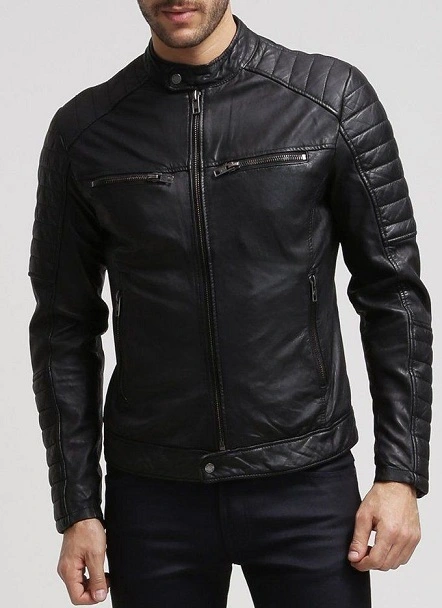
Leather jacket
Leather jackets hve been in trend for a long time. Though it first came to be used during the1900s in World War I, the leather jacket came into fashion starting 1920 and since then they have always been in style one way or the other. During the 1960’s the leather jackets found one more medium of popularity through motorcycle jackets. It became a symbol of style wearing a leather jacket while riding a Harley Davidson. There are a number of jackets in use these days such as Bomber Jackets, Biker Jackets, Leather Coats, Field Jackets, Racer Jackets, Distressed Leather Jackets, Trench Coats, Quilted Jackets, Blazers etc.
3: Leather Belts
Leather belts provide a range of benefits over traditional belts and come in variety of colors, styles and sizes. The biggest advantage of a leather belt is its durability. If the belt is made out of original leather than it is bound to last for years if taken care of properly.
4: Leather Watch Straps
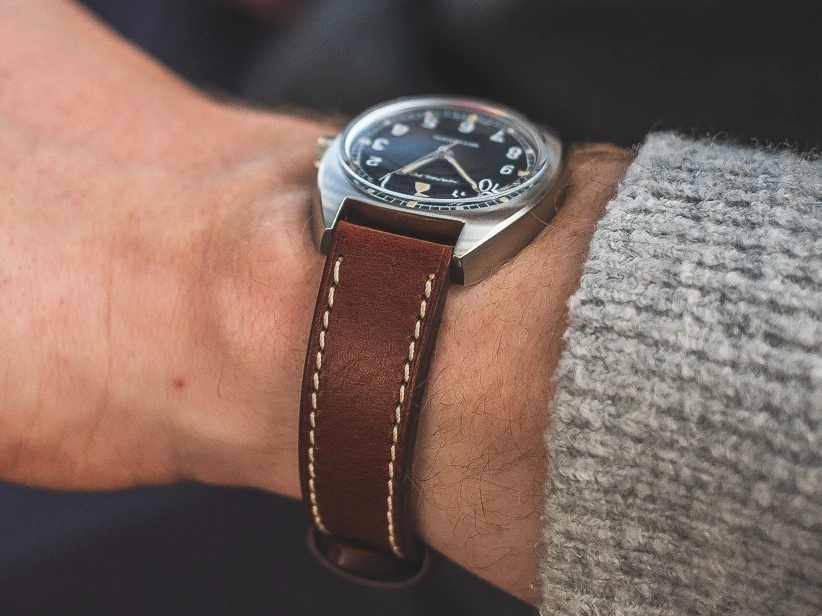
A leather watch strap
Luxury watch straps are often made of leather. Watches that have a leather strap are often expensive and are a sign of status.
5: Leather Apron
Leather aprons can be used at bars, carpentry shops, mechanic work shops etc. and their finish will depend on the type of usage.
6: Leather Gloves
Leather gloves used by factory workers or used to keep hands warm in winter are made with different material.
Leather Bags
1: Leather Backpacks
Leather backpacks popularity has grown and grown as they offer durability with multi pocket options making them an all purpose bag.

Leather laptop backpacks provide padded laptop compartments allowing increasing use of backpacks at workplace.
2: Leather Travel Bags
Travel bags are supposed to handle weight. With a leather travel bag you have material that can handle pressure and at the same time be more than just a dour carrier of material in terms of style.

3: Leather Satchel Messenger Bags
Leather provides durability and vintage aspect to this all round and smart option for work bags. Leather satchels & messenger bags are versatile in their use.
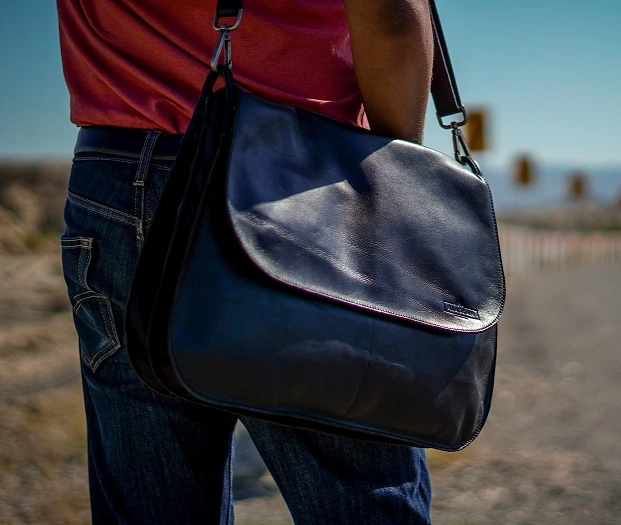
4: Leather Briefcases
Leather briefcases are a true embodiment to a person`s taste in style and add prestige to personality. With laptop compartments and different pockets for dedicated use, the leather briefcase has only gone more complex and burgeoning as compared to its earlier designs. Meant for formal use, leather briefcases add a touch of class to personality rather than being a boring companion to work.
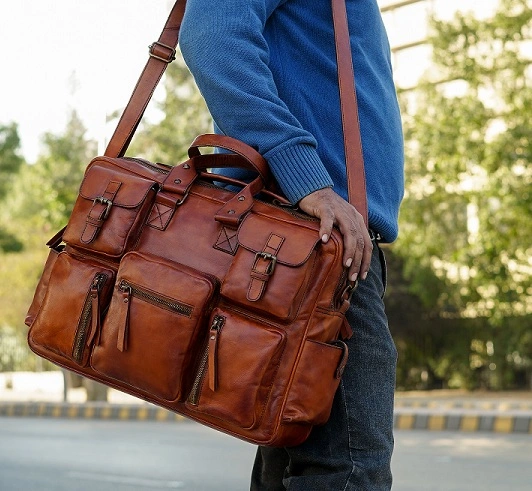
5: Leather Crossbody Bags
Crossbody bags provide you access to your essentials at an arm’s length. Leather cross bodies can be reliable as the leather would provide more durability and reliability to carry cell phones, wallet and other valuables. You can easily share the load on either of your shoulders. They tend to give a sense of being safe as your valuables are always beside you.

6: Leather Totes & Handbags
Leather totes have increasingly become in fashion not only for women but also men. They provide quite a lot of space and can sometimes be very practical when visiting a market and buying items of different orientation. Leather totes tend to look more classy and elegant.

Leather crossbody bags
Sports Leather Goods
1: Leather Balls
A lot of sports use balls made out of leather. Since leather is a tough material it is ideal to use for sports where the impact of pressure and force can greatly tear the surface of a ball. Some common sports that use leather for balls are Baseball, Cricket, Soccer, Rugby etc.
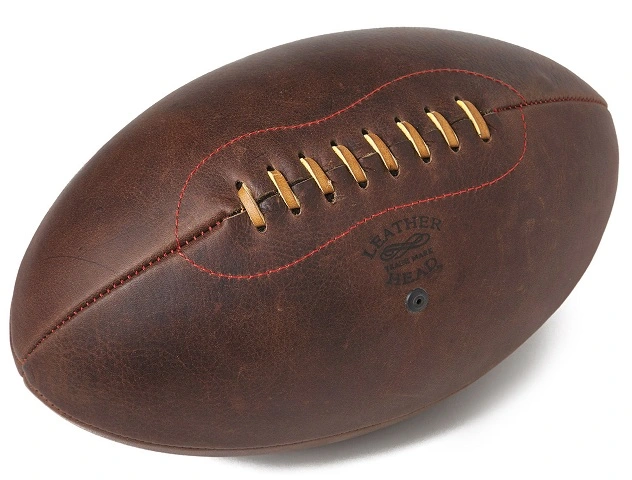
Rugby ball
2: Leather Gloves
There are a lot of advantages of using leather gloves. They can provide a pretty solid grip and protect your hands from damaging. Leather gloves are actively used in motorsports, baseball, hockey, cycling, ice hockey etc.
Furniture
1: Leather Sofas
Leather adds elegance to sofas and the durability aspect stands as it is with characteristics of leather. Appearance wise they can have a big impact on its surroundings. They are easy to clean and also provide better adaptability to people having certain allergies.
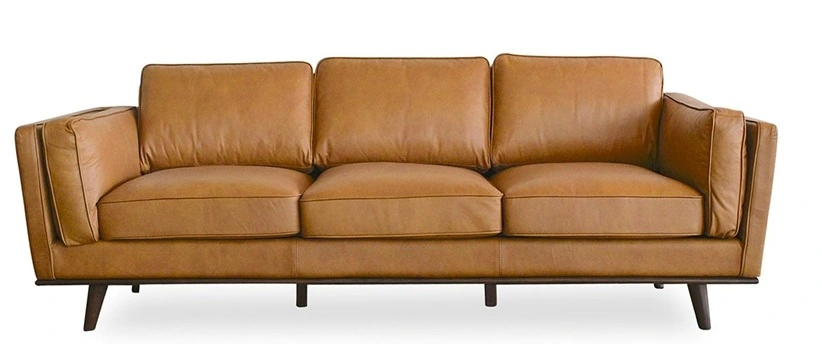
Leather sofa
2: Leather Chairs
A leather chair can last a lifetime if cared for properly. The leather ages very well and is also easy to clean.
Conclusion
On a concluding note, one must say, mankind will keep innovating with leather but the vintage aspect makes leather goods stand in a different league as compared to goods made with other material.

-500x500.jpg)

